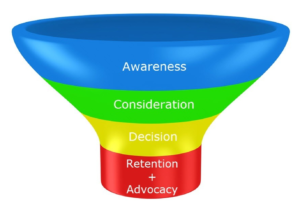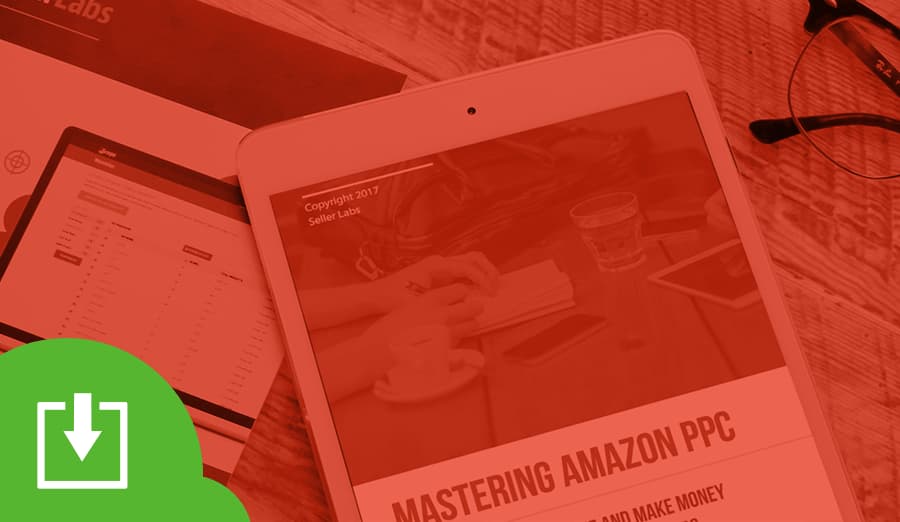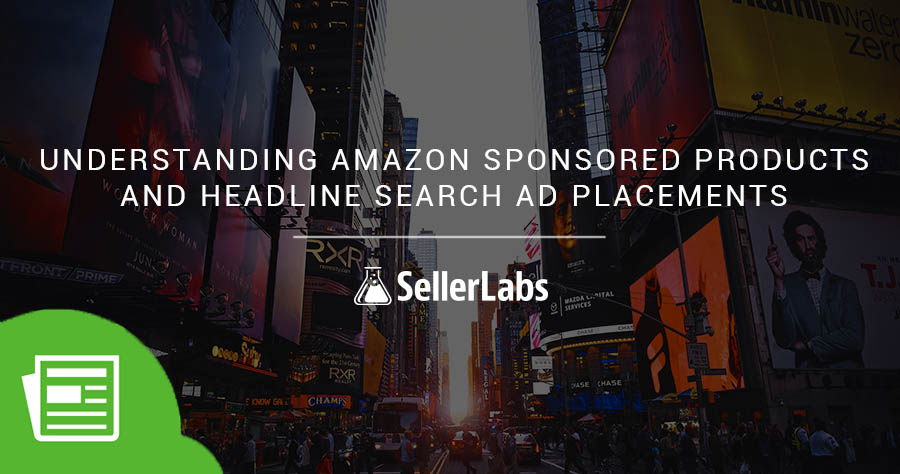Understanding Amazon Sponsored Products & Sponsored Brands Ads Placements

UPDATE: On September 5, 2018, Amazon consolidated all of its advertising offerings into a single program. In addition to the consolidation under the Amazon Advertising umbrella, the “Sponsored Brands Ads” program title was changed to “Sponsored Brands Ads.”
This is a recap from a Facebook Live event we did with Seller Labs founder and CEO, Brandon Checketts. The goal of this event was to help Amazon sellers understand Sponsored Products and Sponsored Brands ad placements, and how they relate to bidding and relevancy for shoppers. Watch the entire replay below.
https://youtu.be/8kYp6S_Vh0k
Recent Amazon Advertising Updates
- Amazon Sponsored Brands ads are now available to everyone—not just in Vendor Central or Vendor Express.
- A trend we’re seeing: Amazon doesn’t care if a seller is 1P or 3P, it wants to make sure ad placements are available and working for sellers of all types.
- Amazon is working hard to achieve parity between the Vendor Central and Seller Central platforms.
Amazon Thinks About Advertising In the Context of the Buyer-Purchase Funnel
- Top: Awareness
- Top Middle: Consideration
- Bottom Middle: Decision/Purchase Intent
- Bottom: Retention & Advocacy

Not every buyer necessarily goes through the purchasing process in these stages. But bigger ticket items take much more time for consideration. In this case, a buyer would go through the purchase funnel. More impulsive purchases go right to the decision making step.
The Soda Example
- Search for soda on Amazon and you’ll see an ad for Coke or Pepsi. This ad is a Sponsored Brands ad or as it’s also known as a Sparkle ad. This is the top advertising placement.
- Below, you’ll see Sponsored Products ads in the search results, right rail and bottom. These ads are meant for people who are ready to buy.
- On the mobile app, the top result is a Sponsored Brands ad for Pepsi and there are not any Sponsored Products ad placements. Amazon has an algorithm that determines when it’s appropriate to show Sponsored Products ads versus Sponsored Brands ads.
- Ads are shown in different places depending on the device you’re using.
Ad Placements You May Not Know About
- Everyone knows about Sponsored Products ads on the main results page and above the product description on a Product Detail page.
- Sponsored Products ads are now showing up on the “Add to cart” page. You’ll see ads related to the product(s) you recently added or just purchased.
- You’ll also see ads on the order placement page below the “Thank you, your order has been placed” box.
- Do an Amazon search for “Apple Slicer” and click on a Sponsored Products ad, and you’ll see Product Display ads, which are only available to 1P sellers. These ads are typically shown on the right-hand rail below the Buy Box. There will also be another ad that looks similar to a Sponsored Brands ad that is just to the left of the Buy Box below the bullet points.
- Product Display ads are targeted toward buyers who are in the consideration phase and price shopping or comparing different products.
- Product Display ads are only available to vendors at the moment but we believe Amazon will make them available in the near future for 3P sellers.
Where Different Ads Fit In The Purchase Funnel
- Awareness = Sponsored Brands Ads
- Consideration = Product Display Ads
- Decision = Sponsored Products Ads
Where Amazon Ads Are Currently Available
| Sponsored Brands Ads | Product Display Ads | Sponsored Products Ads | |
| Vendors (1P) | Yes | Yes | Yes |
| Sellers (3P) | New | No | Yes |
There will be much more parity between Vendor Central and Seller Central in the coming year. Amazon has been aligning the two platforms more and more over the past 18 months.
Understand that the advertising experiences for each ad placement are different for a reason.
Advertising Benefits Between Vendor Central and Seller Central
- You don’t want to run simultaneous ads with similar keywords because you will be bidding against yourself.
- There is only one place for Sponsored Brands ads unlike Sponsored Products ads, which can be found in several locations on the page.
- Each platform has different advantages.
- AMS: You can run ads for any product whether or not you’re properly setup with Amazon’s new Brand Registry program. The Sponsored Brands ad dashboard is better with data and showing existing campaigns.
- Seller Central: Reporting is better for Sponsored Brands ads.
- If you’ve done Brand Registry properly, Seller Central is the way to go.
Sponsored Brands Ads with Search Terms
- Sponsored Brands ads don’t use negative keywords. They lack the refinement of Sponsored Products ads. You can spend lots of money on search terms you think will yield results. This is why many sellers think Headline Search ads are a waste of money.
- Use the search terms that you know will work and run Sponsored Brands ads for those terms. This is an opposite approach to Sponsored Products ads.
- The reporting for Sponsored Brands ads is primarily focused on impressions.
- We expect there will be better reporting in the future that compares your ads to those of your competitors.
Amazon Ad Placement Support In Ignite
| Sponsored Brands Ads | Product Display Ads | Sponsored Products Ads | |
| Vendors (1P) | Amazon: Yes Ignite: Beta | Amazon: Yes Ignite: Beta | Amazon: Yes Ignite: Beta |
| Sellers (3P) | Amazon: New Ignite: Soon | Amazon: No Ignite: No | Amazon: Yes Ignite: Yes |
Ad Placements
- Your bid is not the only factor Amazon considers when displaying an ad. Amazon’s goal is to provide the best customer experience.
- You can’t bid on terms that aren’t relevant to your product. You can’t win an ad placement for the keyword “water bottle” for an apple slicer. Amazon will either reject it or let it get 1,000 impressions or so before it’s removed.
- Amazon will always obey what’s in the shopper’s best interest.
- How does Amazon know if a keyword is relevant to a product?
- Click through rates and conversion rates give a product relevancy. If a product is shown and people click on it, that’s a solid identifier of a product’s relevancy. And a conversion is an even better indication of keyword/product relevancy.
- If your competitor has a 12% conversion rate and you have a 5% conversion rate, they’ll win the ad placement. The wider the discrepancy, the harder it is to get placements.
Which Ad Placement Locations Convert the Best?
- Amazon doesn’t currently give sales data based off of placement location.
- Amazon doesn’t want sellers to think about ads in terms of placement but rather in terms of optimizing conversion rates.
- You won’t find placements in any of the reports.
- Basically, better placements get better conversion rates.
- More than 60% of people click on the first three things in the search results.
- Sponsored Products ads will generally have the highest conversion rates of the three ad types.
- Product Display ads have performed poorly in the past but Amazon has added a second location to help improve their conversion rates.
How Does Ignite Help Sellers?
- Ignite helps sellers walk-through Amazon PPC advertising basics like how to structure campaigns, how to pair the right products, how to build out campaigns and ad groups, etc.
- Ignite has algorithms focused on bidding and keyword suggestions. The program will give you suggestions to help sellers get the most ROI on their ads.
- It removes a lot of the math and Excel spreadsheet analysis.


Jessica Wright is the in-house "Amazon Genius" for the Seller Labs Managed Services team. Her focus is working with our team members and clients to educate and answer tough Amazon questions in areas outside of PPC advertising. With 15 years of manufacturing and eCommerce experience on both the brand and agency sides of the business, Jessica is knowledgeable in all things Amazon and is constantly seeking out the latest updates to help Seller Labs clients stay ahead.






